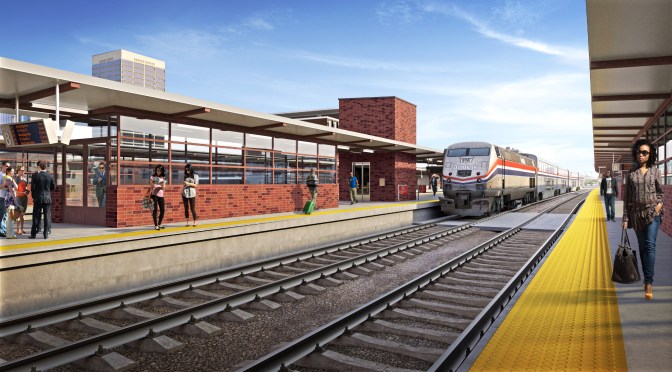Special Guest Blog by Fred Frailey
We would all agree that he was a genius at breaking down railroad operations to its simple components and running trains economically. Hunter Harrison learned railroading at the knee of a brilliant, profane Texan, William (Pisser Bill) Thompson, who was on his way to becoming VP-operations of the Frisco in the late 1960s when Hunter encountered him at Tennessee Yard in Memphis. “Young man,” said Thompson, spreading his arm toward a sea of freight cars, “what do you see out there?” “A lot of good business, Mr. Thompson,” replied Harrison. Retorted Thompson: “What? Good business? See, that’s the difference, Hunter. I see a bunch of delayed cars, and you say it’s good business.” Hunter Harrison retold that story the rest of his life, which ended unexpectedly in mid-December from complications of a respiratory disease.
From lessons such as this, Harrison learned inventory control and asset utilization. Later, within Burlington Northern’s Seattle Region, he tried before others did to run individual cars strictly by schedule, thereby getting better utilization of equipment, including locomotives. Later still, running operations at Illinois Central, he put into practice all the ideas that had been brewing within him, including balance—if you run a train east, run one west, and better yet, have them meet mid-way and swap crews, thereby ending away-from-home expenses. He later did his magic at Canadian National and Canadian Pacific, and upon his death was eight months into a remaking of CSX.
So a genius at railroad operations, yes. But was the man a genius at running a railroad? Running a railroad, after all, is about more than running trains. You have to consider retaining your customers and finding new ones, dealing with government, building high morale and on and on and on. No, he was not a genius, and in fact I would call the man merely ordinary in some aspects of being a chief executive and deficient in a few critical areas. To say this does not detract one iota from the respect I have always shown for him. We are all imperfect creatures.
Harrison was so focused on operations that other aspects of the CEO’s job may simply have bored him or conflicted with his operating policies. His big blind spot at Canadian National was customers, getting them and keeping them. I wrote (see “Hunter’s Way,” August 2009) that he insisted customers load cars seven days a week. The natural traffic cycle is low volume Sunday and Monday, building to a crescendo on Friday and into Saturday. This played havoc with his desire to achieve operational balance, running the same trains every day, each way, and thereby always having cars, locomotives and people in the right place.
To force customers to play the game his way, Harrison had his marketing vice president, Jim Foote, institute low rates for early in the week and successively higher rates through Friday. It worked, I guess, but at the cost of alienating the customers, who were bludgeoned into changing their way of doing business. One of the first things Claude Mongeau did upon becoming Harrison’s successor in 2010 was to publicly apologize for the way customers had been treated and pledge to turn over a new leaf, which CN did.
Later, at Canadian Pacific, Harrison’s blind spot became politics. You may recall he tried to publicly entice Norfolk Southern’s new chief executive, Jim Squires, into agreeing to a merger of their railroads. Squires didn’t just say no, but hell no, and to make sure Harrison got the point, put the full weight of Norfolk Southern’s formidable Washington, D.C., office into poisoning the well within the federal government. The effect NS had in Washington must have stunned Harrison, who told me years earlier that visiting Ottawa or Washington was “a waste of time.” CP did not have a Washington office, just a law firm that did lobbying under contract. Harrison, clueless to the intricacies of the political process, was publicly humiliated and gave up his grand plan to get the final round of mergers rolling.
But give the man his due. What Mongeau did at CN was keep Harrison’s operating practices intact while instituting more customer-friendly policies, along with some sophisticated initiatives that wed the railroad to the specific logistical needs of customers. The result is the hugely successful Canadian National you see today. Harrison’s protégé at CN and CP, Keith Creel, now chief executive of Canadian Pacific, is giving marketing and customer relations the attention that his former boss did not. I expect good results. Hunter Harrison’s practices, modified by customer-friendly policies, are a win-win combination.
This bring us to CSX and 2018. Did Harrison put the railroad on the right path or leave it in shambles, having ripped its practices and institutional knowledge almost to shreds while not living long enough to build a new foundation? I wish the former but suspect the latter.
His former colleague at CN and now his successor at CSX, Jim Foote, has his work cut out. I interviewed Foote in 2009 and thought him whip-smart and funny (meaning a quick thinker). Nowhere in his background is experience in operations. And operations is where CSX now stands exposed.
Lastly, I wish Hunter Harrison had been better teaching people how to think like him than he was, through his Hunter Camps, to act like him. It’s an important distinction. In other words, you can tell me what to do (Hunter Camps) but how do I learn to think like you? Maybe that is our biggest loss.















